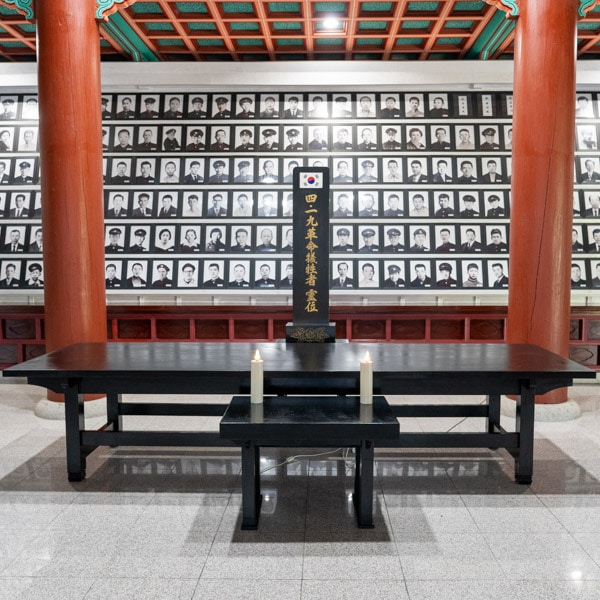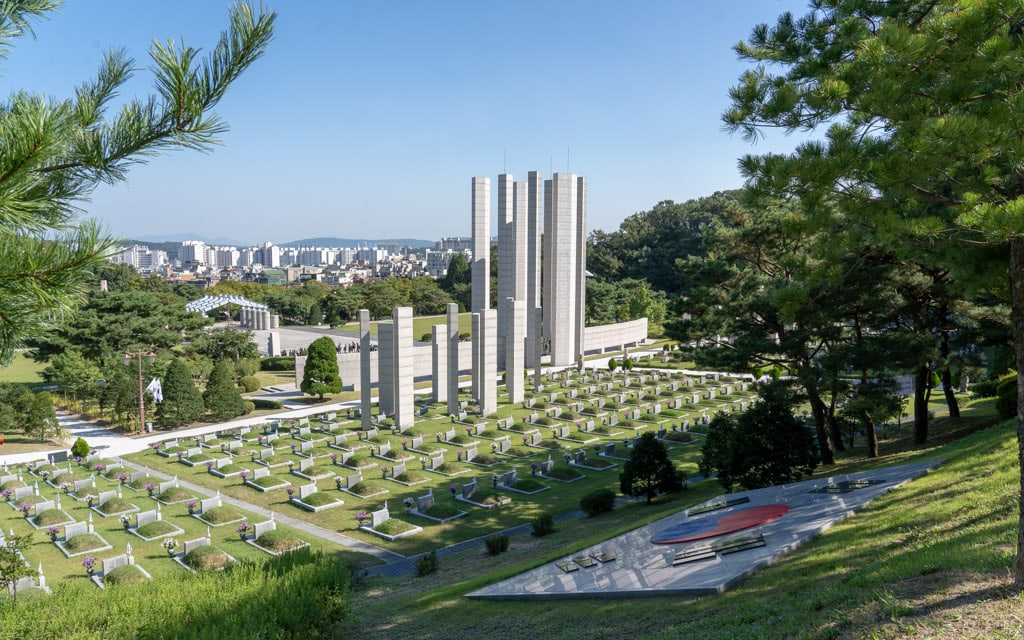
The April 19th National Cemetery is a cemetery and memorial dedicated to the 224 lives lost during the April 19 Revolution protests. During these protests, which took place between April 11 and April 26, 1960, hundreds of citizens, mostly students, were killed or injured by the authoritarian government ruled by President Syngman Rhee. Rhee was a dictator who used his power for corruption and to rig elections. These heroes sacrificed their lives for freedom, democracy, and justice for all of Korea.
The April 19th National Cemetery is located at the base of Bukhansan Mountain in the Suyu-dong neighborhood of northern Seoul. At the cemetery, visitors will find a white memorial tower, memorial hall, exhibition hall, multi-purpose plaza, and a pond. The relaxing location of the cemetery, surrounded by lush forests and trees, is beautiful. The total area of the April 19th National Cemetery is 96,837㎡ (23.93 acres).
History of the April 19 Revolution
The April 19 Revolution, also known as the April Revolution or April 19 Movement, were a series of mass protests held in South Korea between April 11-26, 1960. The protests were held against President Syngman Rhee, the first president of South Korea, and the government, known as the First Republic of Korea. Rhee was first elected president on July 20, 1948. In 1956, Rhee was re-elected for a second term. In 1958, Rhee modified the constitution, removing the two-term limit. This, along with a weak economy and lack of social development, angered many Koreans. Citizens saw Rhee as a corrupt dictator who used his political powers to silence any opposition.
Several weeks before the March 1960 South Korean presidential election, Cho Pyong-ok, the main opponent of Rhee, died of cancer. Because of this, Rhee was re-elected unopposed. Allegations of corruption and manipulation of the presidential and vice presidential elections sparked outrage with citizens, eventually leading to the April 19 Revolution. On March 15, the same day of the election, a protest against the election was took place in the city of Masan in the southern part of the country. At these protests, police fired weapons as protestors threw rocks.
On April 11, the body of a student who disappeared during the protests was found. It was determined that the student died after being struck in the head with a tear gas canister fired by people. Rhee and the government tried to censor the story, but it was too late. The news of the death, which shocked Koreans, spread across the nation and across the world.
On April 19, as many as 100,000 students from high schools and universities across Seoul marched to Cheong Wa Dae (Blue House) to call for Rhee’s resignation. Proclaiming martial law, Rhee had police fire on the protestors. In the end, (180) were killed and thousands were left injured. This day would be known as “Bloody Tuesday.”
By April 25, protestors, including students and teachers, outnumbered police. Police refused to fire on the protestors. The next day, Rhee stepped down as the president where he was eventually exiled to Hawaii until his death in 1965.
What to see at April 19th National Cemetery
Symbol Gate
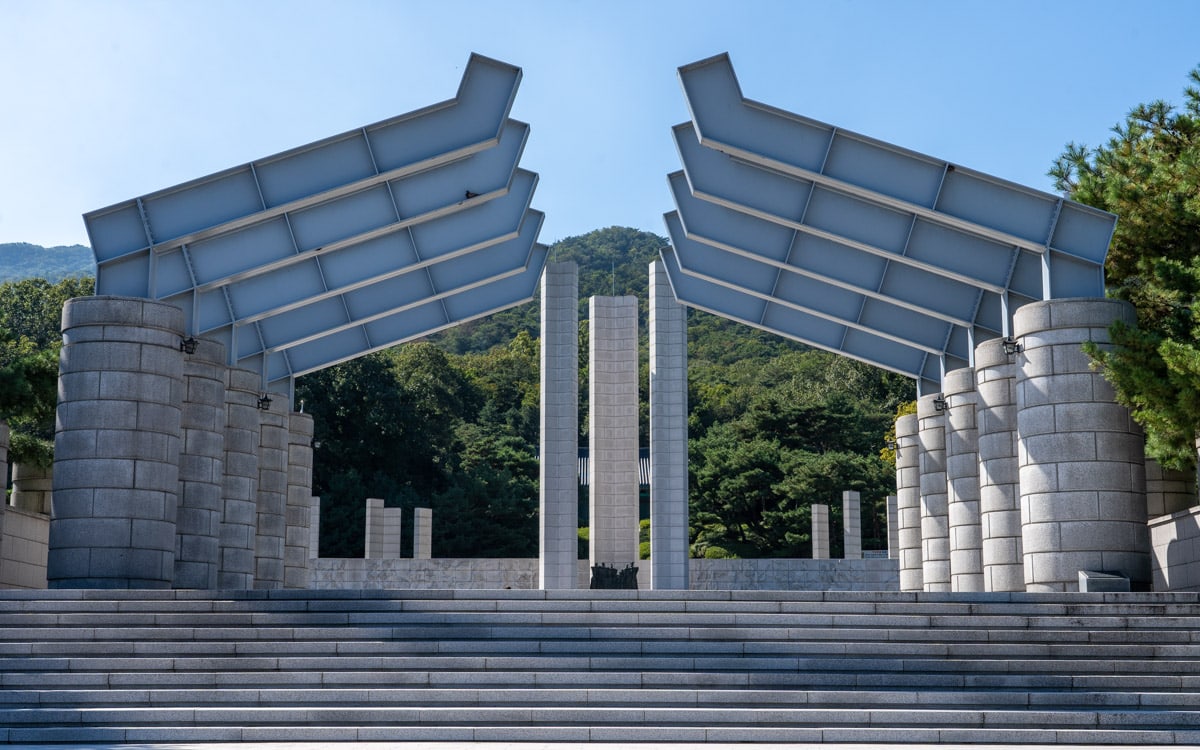
As you enter the cemetery and make your way past the parking lot and through the multi-purpose plaza, one of the first sights of interest you will encounter is the Symbol Gate. This steel tower, with five circular stone posts on each side, separates the multi-purpose plaza from the April Student Revolution Monument. The gate acts as a separation between the modern world and the heroic, spiritual world where hundreds are buried.
April Student Revolution Monument

Located at the center of the cemetery is the April Student Revolution Monument. This monument commemorates the spirit of those involved in the April 19 Revolution. Many young people sacrificed their lives in their fight against corruption and injustices caused by President Syngman Rhee and the First Republic. And, many of those involved in the revolution are buried in the cemeteries behind the monument. Construction on the April Student Revolution Monument began on September 20, 1963. The monument consists of seven granite towers which are 21 meters (68 feet) high.
Military Relief Sculpture

The Military Relief Sculpture flanks both sides of the April Student Revolution Monument. The granite sculpture, which folds out like a screen for 47 meters (154 feet), tells the story of the April 19 Revolution from beginning to end. The first scene depicts the injustice and wickedness of Rhee and his government. The second part depicts the protests of the students against the government. The third scene depicts the victory over Rhee. And, the final scene depicts freedom and peace.
Guardian Statue

Also located on each side the April Student Revolution Monument are Guardian Statues. The granite statues depict a man and woman who are using their strength to defend justice and freedom in Korea.
Cemetery

Located behind the April Student Revolution Monument are the cemeteries with the graves of hundreds of heroes who scarified their lives for their country. These brave citizens, many young students, fought against injustice and corruption for freedom and democracy. By sacrificing themselves, they have made the world a better place today. Their actions led to a political system which reflected the will of its people. This is their final resting spot where they can be honored and remembered for generations to come. The total area of the cemetery space is 6,612㎡ (1.63 acres).
Flame of Justice Sculpture
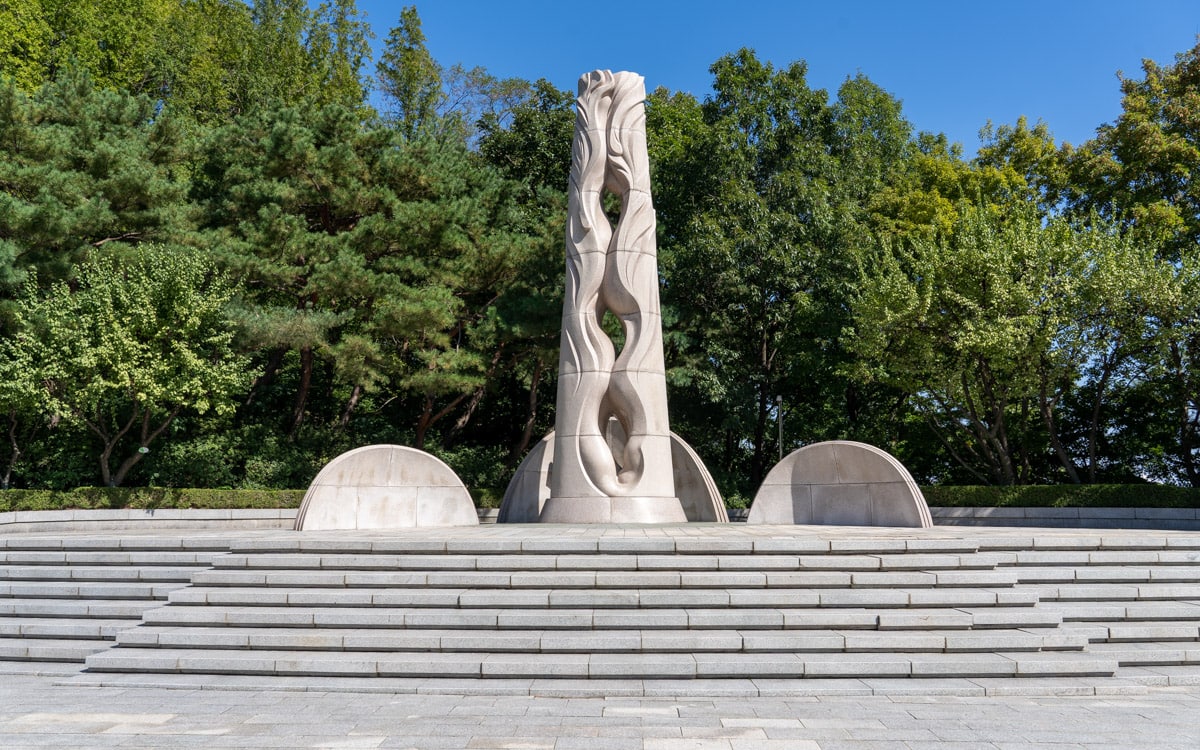
The Flame of Justice is a sculpture which expresses the April 19 Revolution in the shape of a flame. The 10 meter (32 foot) semicircular granite sculpture depicts three rose petals opening up in the shape of a flame.
Freedom Fighter Sculpture

On the northern end of the cemetery is the Freedom Fighter Sculpture. This horizontal 12 meter (39 foot) sculpture depicts the violent confrontation between students with the armed riot police during the April 19 Revolution.
Yuyeongbong Portrait Hall
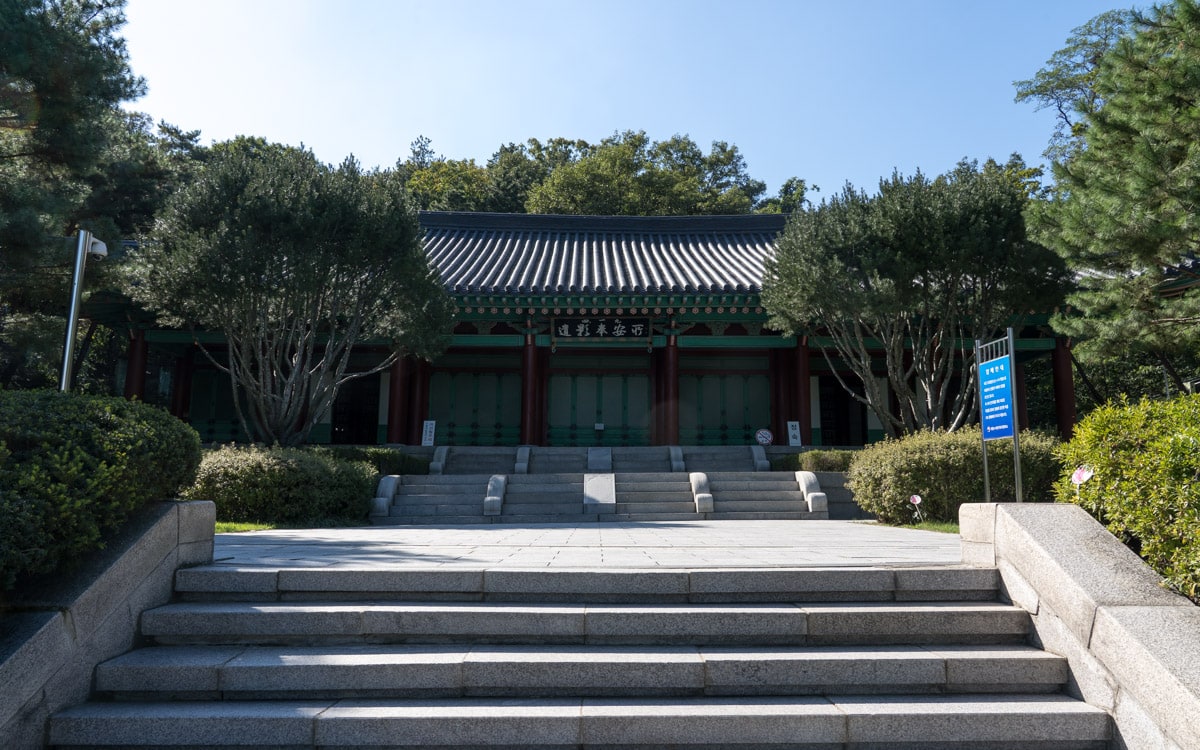
Hidden in the innermost section of the April 19th National Cemetery grounds, up a stone stairway, is the Yuyeongbong Portrait Hall. Inside this hall are the portraits and tablets of those who sacrificed their life for freedom, justice, and peace during the April 19 Revolution. This includes hundreds of citizens of all ages including university and high school students. These portraits act as a reminder to future generations of the struggle and sacrifices of those involved in the April 19 Revolution. They fought for peace and democracy which Korea enjoys today.
April 19th Revolution Memorial Hall
The April 19th Revolution Memorial Hall is a place where visitors can learn everything about the history of the April 19th Revolution. Displays, photographs, videos, and other information allow visitors to learn the history of the April 19th Revolution including what led up to the revolution and what happened after. If you are interested in Korean history, this is a must. On the 3rd floor of the Memorial Hall is an observatory.
Root of Democracy Sculpture

Down the street from the April 19th National Cemetery, surrounded by the streets and buildings of northern Seoul, is the often missed Root of Democracy Sculpture. This simple sculpture represents the spirit of the people as they rose up against the injustices of the government. The sculpture consists of nine granite columns ranging in height from 2 meters (6.5 feet) to 10 meters (32.8 feet). Whether you are arriving at or leaving the cemetery, be sure to stop by this sculpture.
April 19th National Cemetery Information
Hours
National CemeteryMarch-October: 6:00-18:00
November-February: 7:00-18:00
The National Cemetery is open everyday.
Memorial Hall
March-October: 9:30-17:30
November-February: 9:30-16:30
The Memorial Hall is closed on Mondays.
Admission
Free
Address
17 4.19-ro 8-gil, Gangbuk-gu, Seoul
GPS Coordinates: 37.648061, 127.008377
April 19th National Cemetery Video
Map
Additional Resources
Viator by TripAdvisor
Viator is a popular online platform that helps travelers book tours, activities, and unique experiences worldwide, including in Seoul. It connects users with a wide selection of options – from sightseeing tours to cultural events and outdoor adventures – all offered by local providers.
Klook
Klook offers discounted tickets and reservations for various attractions and services in Seoul, from theme parks and museums to tours and transportation options.
Rakuten
Save money while exploring Seoul with Rakuten's cashback program. Book your hotels or other services through Rakuten and enjoy cashback rewards and exclusive deals.
If you sign up using the link below, you could earn $30 cashback on your first purchase over $30.
Book Recommendations
For an immersive guide to Seoul, many travelers choose to bring a book along. Fodor's Seoul, for example, offers detailed recommendations on sights, restaurants, maps, and travel tips.
Nearby Sights
Hwagyesa Temple
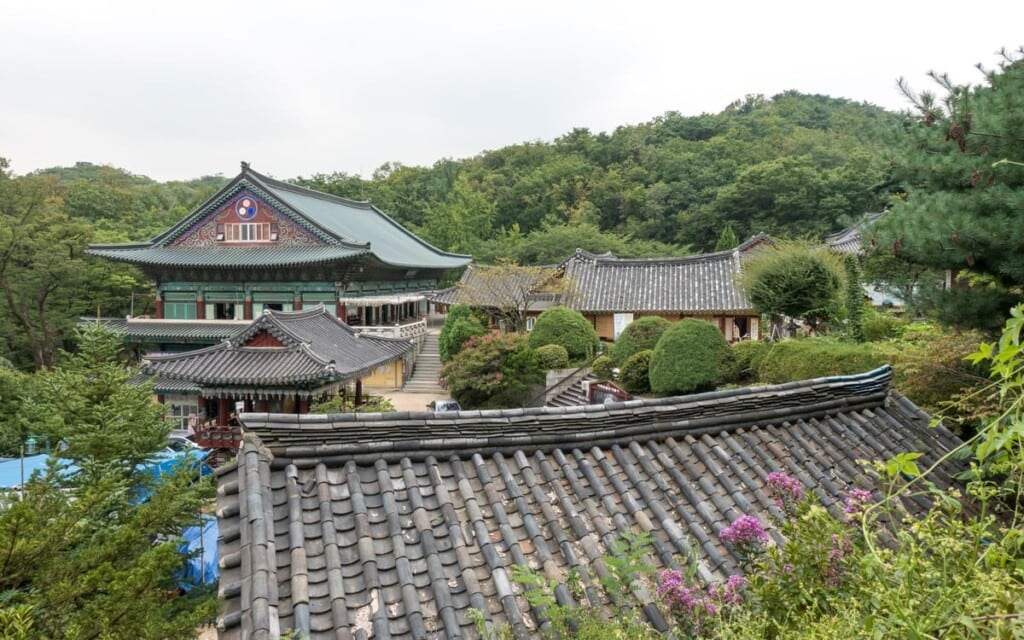
Hwagyesa Temple, of the Chogye Order, is a Buddhist temple surrounded by beautiful scenery at the foot of Mt. Samgaksan in Suyu-dong, Gangbuk-gu. Walking around the peaceful temple grounds surrounded by mountains, running streams, and nature makes any visitor feel like they are far from the urban maze of Seoul.
Bukhansan National Park

Bukhansan National Park is a national park located in the Seoul metropolitan area popular for its scenery, hiking trails, streams, and granite peaks. The park is named after the tallest mountain in Seoul, Bukhansan, which means "mountains north of the Hangang River." on April 2, 1983, Bukhansan became the 15th national park of Korea.
Dream Forest
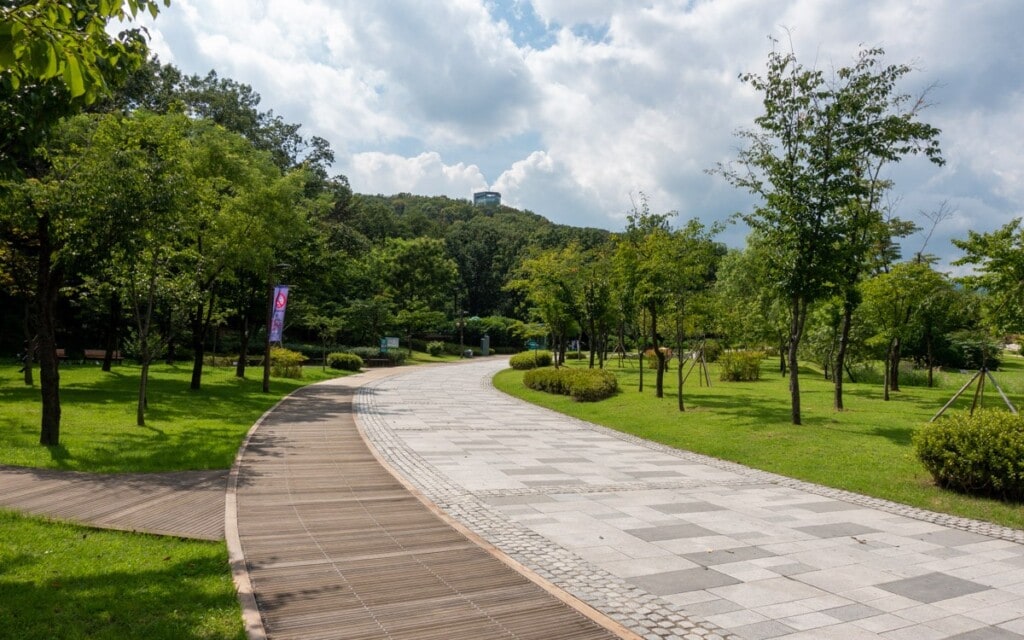
Dream Forest is a large park located in Gangbuk-gu which features open spaces and many walking trails. The area was formerly known as Odong Geullin Park. On October 17, 2009, renovation work was completed and the park was renamed as Dream Forest. At 660,000 square meters, (7,104,180 square feet), Dream Forest is the fourth largest park in Seoul after after World Cup Park, Olympic Park, and Seoul Forest.
Nowon Culture Street

Nowon Culture Street, located near Nowon Station in northeast Seoul, is a government created entertainment and shopping district known for its nightlife. This district might not be the most well known in Seoul, but it still offers visitors a wide variety of nightlife including restaurants and bars without the huge crowds.
Last Updated on Apr 20, 2022
